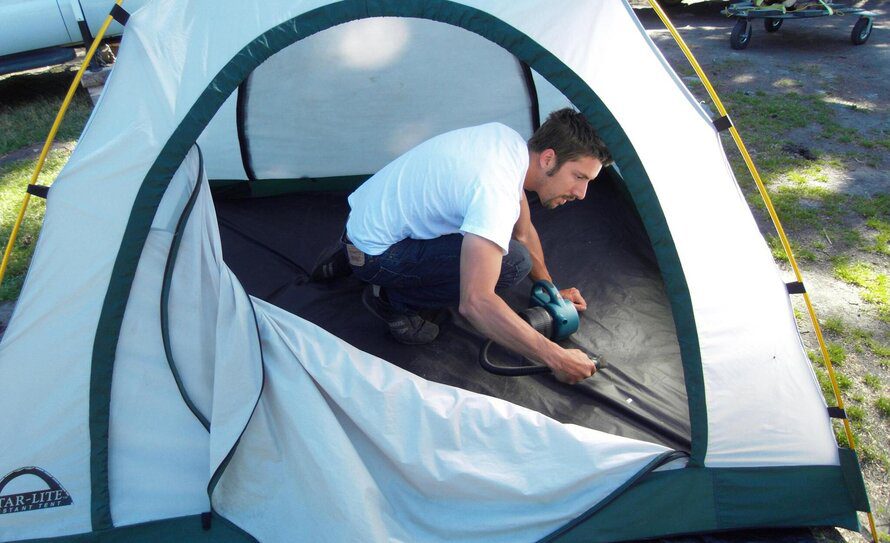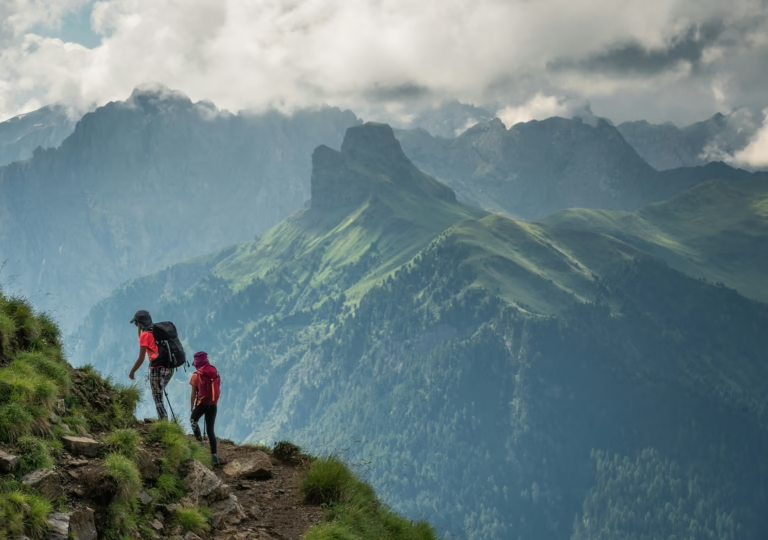Few things ruin a camping trip faster than a messy tent. A nasty odor might be the first problem you notice, but there’s a bigger threat lurking: mold. Mold in tents can actually be a huge health hazard.
A recent study in the Journal of Integrative Neuroscience highlights this very concern.
That’s why proper tent care is crucial. In this article, I’ll walk you through the step-by-step process of cleaning your tent, from pre-cleaning to re-waterproofing. This way, you’ll have a fresh, clean, and safe home away from home for your next adventure. Let’s begin!
How to Clean a Tent
To clean your tent, gently hand-wash it in a bathtub with cool water and mild, non-detergent soap. Avoid harsh cleaners. Rinse thoroughly and air dry completely in a shaded area before storing to prevent mold and mildew.
And now for the long version of this guide…
1. Pre-Clean
I always make it a habit to give my tent a quick once-over before I pack it up. Think of it as a health check for your home away from home! Shake the tent vigorously to dislodge any loose dirt, leaves, or debris that might be hiding inside.
Then, take a soft brush and gently sweep away any clinging dirt from the outside. This simple pre-clean saves me a ton of time and effort when I do the more thorough cleaning later.
2. Spot Clean
Now, let’s get to those inevitable stains.
- Easy stains: For smaller smudges or light dirt, a simple sponge and plain water usually do the trick. Remember, less is always more with tent cleaning – a gentle approach is best to avoid damaging the fabric.
- Tough stains: If you’re facing tougher stains like food spills or bird droppings, here’s what works for me: I mix a tiny amount of specialized tent cleaner with lukewarm water in a bowl. Then, I dip my sponge, wring it out well so it’s damp but not soaking, and lightly scrub the affected area.
- Sap stains: Speaking of tough stains, tree sap is a common culprit. The best way to clean a tent covered in sap is with rubbing alcohol. Just dab some onto a cotton ball and gently work on the sap until it dissolves.
While it may seem easier to use any type of soap you have at hand, a specialized tent cleaning solution is your best choice, and here’s why, according to Konrad Warzecha at mendooutdoors.com:
First of all make sure not to wash it with any soaps, detergents or anything. You can buy special products that are used for tents. This is so that you preserve the waterproofness of the tent. I usually just wash it in clean water and let it air dry.
Konrad Warzecha
Also, harsh chemicals are a big no-no…
It might be tempting to grab that bottle of bleach or harsh detergent sitting under your sink, but trust me, you don’t want to go there. Those chemicals will wreak havoc on your tent’s waterproof coating and fabric over time.
A leaky tent during a downpour is no fun, so avoid harsh chemicals altogether!
3. Deep Clean (If Necessary)
Sometimes spot cleaning just isn’t enough. Maybe you just came back from a long adventure, or maybe there’s a lingering musty odor that won’t quit. That’s when a deep clean becomes your best friend.
Prep the bath: For me, the bathtub usually becomes my cleaning station, but a large plastic storage bin works in a pinch. Fill it with lukewarm water and add a specialized tent cleaner, following the dilution instructions carefully.
Submerge: Unzip all the doors on your tent and rainfly, then flip them inside out. Completely submerge them in the cleaning solution, making sure everything gets a good soak.
Soak and agitate: Check the recommended soak time on the tent cleaner you’re using. To help loosen any stubborn dirt or grime, I like to gently swirl my hand around in the water now and then.
Tip: If you’re wrestling with a massive family tent, you might need to conquer it in sections due to limited tub space. Just focus on one part of the tent or rainfly at a time.
4. Rinse Thoroughly
Rinsing is key here – don’t skimp on this step! You want to remove all traces of soapy residue, which can attract dirt and actually weaken your tent’s waterproofing over time. Drain the dirty water and refill your tub with clean water.
Rinse your tent and fly meticulously until the water runs completely clear. Be patient, it might take a few rinses to ensure all the soap is gone.
5. Hang to Dry
I’m a stickler when it comes to drying my tent. The absolute worst thing you can do is toss a still-damp tent into storage – it’s the perfect environment for mold and mildew to take hold. Instead, after rinsing, find a well-ventilated spot out of direct sunlight to hang your tent and fly.
If weather and space permit, pitch your tent completely to help speed up the drying process. Check all the hidden corners and seams to ensure every inch of the fabric is completely dry before you pack it up.
6. Re-Waterproof
After a good wash, I also make time to re-apply a DWR (Durable Water Repellent) treatment. This helps restore the water-resistant coating, ensuring you stay dry and protected even in unexpected rain showers. Take your time, follow the product instructions carefully, and make sure you achieve even coverage.
Not sure if it’s time to re-waterproof? A quick test: Sprinkle a bit of water on your tent. If the water beads up and rolls off, you’re good to go. But if it soaks into the fabric, it’s time for a fresh DWR coat!
FAQs
How to clean a tent with mold?
To clean a tent with mold:
- Pitch it outdoors.
- Mix equal parts white vinegar and water.
- Apply the solution to the mold and let it sit for an hour.
- Wipe clean and rinse thoroughly.
- Air dry completely in the sun.
Can you wash tent in washing machine?
Washing the tent in the washing machine is not a good idea. The agitation and harsh detergents can damage the fabric, compromise waterproof coatings, and potentially even tear seams.







